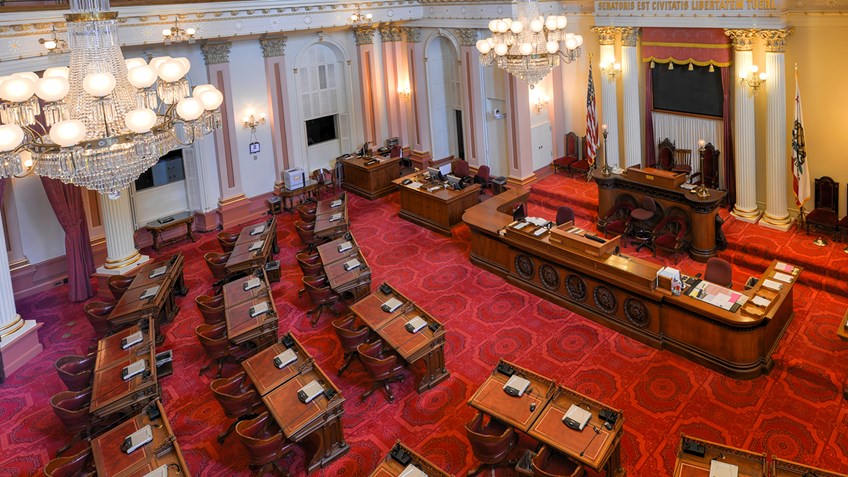
Justice Court. (Photo: Nirat.pix/Shutterstock)
Teaching Law Students the Intricacies of Legislative Drafting
Students who take this course will be prepared to work in or around the California State Capitol
By Chris Micheli, May 16, 2022 3:40 pm
At the University of California, Davis King Hall School of Law, the author co-teaches a 2-unit, semester-length course dedicated entirely to legislative drafting. Meeting weekly for 2-hour sessions, students in this course are provided practical experience in researching, analyzing, and drafting legislative measures in the State of California, including bills, resolutions, and constitutional amendments.
The author has co-developed a skills-based course for students to be trained in drafting and amending legislative measures. The class is limited in enrollment size in order to ensure that students have significant interaction with the instructors with “hands-on,” practical work writing and reviewing drafting assignments.
By way of background, legislative drafting is a particular genre of legal writing. It has been called the most difficult form of legal writing because it often addresses complex, societal problems. This course provides students with insight into the California legislative process and students develop extensive research and writing skills related to legislative drafting. They are required to engage in constitutional and statutory research, including federal and state laws, as well as drafting and revising legislative measures.
Students read and study about the theoretical and practical aspects of legislative drafting, how statutory law is created, constitutional limits to lawmaking, and many more topics throughout the semester. This academic work is combined with numerous drafting exercises, with at least one drafting assignment due each week throughout the semester. Students do not simply read legislative measures; they draft them regularly.
Among the goals of the course are for students to gain a deeper understanding of the state legislative process, legislative drafting skills, theories of statutory interpretation, and constitutional restrictions on lawmaking, as well as to develop the tools needed to craft clear and effective legislation. Drafting guidelines and techniques are studied and applied in practical exercises each course session.
The course uses the textbook, “An Introduction to Legislative Drafting in California,” Micheli, Kendall-Hunt Publishing Company, 2021, as well as a Supplemental Reader compiled by the author.
The primary learning objective of this course is to help students understand the intricacies of legislative drafting, with a focus on California, but examples from Congress and other states are reviewed. The course covers all aspects of drafting legislative measures, with particular attention to students focusing on their weekly assignments and in-class exercises.
Students who take this course will be prepared to work in or around the California State Capitol, whether working as government employees, non-profit or issue-specific advocates, labor or corporate officials, or other “third house” representatives. Students will also be better able to research, read, and understand legislation generally. In addition, they are able to improve their ability to interpret and analyze state and federal statutes and their ability to clearly express concepts and ideas in writing.
The secondary learning objective of the course is to promote an understanding of employment opportunities for students outside the traditional law firm environment or prosecutor or public defender worlds. There are many pathways available for attorneys interested in public policy, particularly with the presence of significant state government decision-making in Sacramento. Finally, the course’s students are able to understand the role of a legislative drafting attorney and how to research, draft, read, and understand legislation.
There is an enrollment cap of 12 students admitted to the course each year. Grading is based upon 75% for the weekly drafting exercises and 25% for the bill drafting project due at the end of the semester. There are 15 assignments worth 5 points each for a total of 75 points and a final exam is worth 25 points.
In addition, the course is interactive and student participation is crucial to their learning experience. In-class discussion and exercises are an integral part of the course. The professors also begin each class with a review and debriefing on the prior week’s assignment so that students gain a clear understanding of what was expected.
In the first class, legislative drafting and its importance are discussed. An overview of legislative drafting and several of its guiding principles are covered. A review of the state and federal legislative processes occurs, followed by a discussion of the drafter’s role in the legislative process.
In the second class, research for and reading legislation are addressed. This includes the organization and structure of state and federal bills, and a class exercise requires using state and federal legislative websites. Students review bill drafting examples and the steps needed to research prior to drafting. Understanding how to read a bill, including form, substance, and technical writing is the focus. The assignment is to draft a spot bill and an intent bill.
In the third class, determining and understanding statutory construction and legislative intent are the focus. Findings and declarations by the Legislature are reviewed and the in-class exercise is to brainstorm legislative findings and declaration. Time is spent understanding the general process for drafting legislative measures.
In the fourth class, avoiding ambiguity and legalese in legislative drafting are the focus. Students cover the use of plain meaning and the in-class exercise is to edit an existing statute.
In the fifth class, students cover drafting style rules and the in-class assignment is to correct style in a statute. There is also discussion about integrating draft language into an entire statutory scheme and drafting the Legislative Counsel’s Digest. The weekly assignment is to draft a Digest.
In the sixth class, the emphasis is understanding and addressing possible constitutional concerns with legislative measures, such as federal preemption. Time is spent reviewing other state laws and how they assist in drafting legislative measures. Gaining an understanding of drafting criminal laws is an additional focus and the weekly drafting assignment.
In the seventh class, the issue of vote keys is reviewed, as well as the use of form language. Understanding appropriations and fiscal bills are next. State-mandated local programs are discussed, and class-exercises cover these. The weekly assignment is to draft a fiscal bill.
In the eighth class, we discuss effective and operative dates, as well as issues such as “chaptering out,” contingent enactment, and urgency clauses. Drafting new state entities is the topic of the weekly assignment.
In the ninth class, students understand using other states’ laws, including using them to draft legislation. The in-class exercise is to research and use another state’s law for a bill draft. So, too, are students taught to use model acts and uniform codes. Drafting tax laws are also covered, which is the basis for the weekly drafting assignment.
In the tenth class, the focus is on drafting amendments, including amendments versus original bill language. The topics of pilot projects and special statutes are discussed, and in-class exercises highlight these types of measures. The weekly assignment is to draft a special statute bill.
In the eleventh class, we cover resolutions. There are three types used in the California Legislature and understanding the purposes and types are covered. There is discussion of drafting considerations for resolutions, as well as in-class exercises. The weekly assignment is to draft a specific type of resolution.
In the twelfth class, there is extensive discussion about drafting initiatives and considering important issues such as amendments versus revisions, and drafting considerations for proposed ballot measures. The in-class exercise is to draft an initiative, which is also the weekly assignment.
In the thirteenth class, we begin putting everything together and discuss key drafting considerations. In addition to reviewing sample bills from different jurisdictions, students understand the role of the bill drafting, including working with bill requestors and client confidentiality.
In the fourteenth class, the focus is on putting all of the facets together in order to draft an entire bill, which is the final exam. Students review many sample bills, as they have throughout the course, and prepare for their final assignment to draft an entire bill.
Students in this course benefit from practical drafting experience and, at the conclusion of the course, will be able to draft several different types of legislative measures.
- Confidential Marriages in California - July 10, 2025
- Emergency Protective Orders in California - July 9, 2025
- Recreational Marinas in California - July 8, 2025






